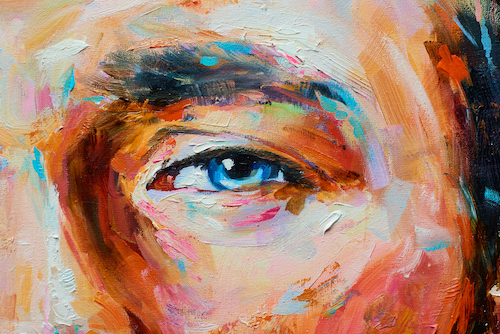Discover Timeless Artwork Oil Paintings for Sale Today
Wiki Article
Exploring All Regarding Oil Paints: An Overview to Comprehending Their Charm and Value
Oil paintings have mesmerized target markets for centuries, using a look into the artistic mastery of various eras. Their rich history is intertwined with cutting-edge strategies and extensive psychological expression. Understanding the products and approaches behind these art work can improve admiration. In addition, the marketplace for oil paints presents opportunities for collectors and financiers alike. As one discovers this interesting world, the question emerges: what makes an oil paint genuinely important?The Background of Oil Paint: A Journey Via Time
Oil paint has roots that date back to ancient times, it absolutely grew throughout the Renaissance, when musicians discovered its versatility and abundant color capacity. Early examples can be mapped to the 7th century, with techniques evolving especially across societies. The medium came to be famous in Northern Europe in the 15th century, specifically with the jobs of artists like Jan van Eyck, that pioneered its usage for comprehensive realistic look and dynamic tones. This period noted a departure from tempera paints, permitting better depth and texture. As oil paint spread, it affected plenty of artists, bring about masterpieces by prominent figures such as Leonardo da Vinci and Rembrandt. The tool's heritage continues, shaping the art globe well into contemporary times.Understanding Oil Paints: Materials and Techniques
As musicians explore the world of oil paints, they run into a diverse variety of products and techniques that define this medium. The key components of oil paint include pigments, which provide color, and drying out oils, such as linseed, that bind the pigments and facilitate application. Different ingredients can change the paint's appearance and drying time, improving versatility. Techniques like glazing, where transparent layers are constructed up, and impasto, which entails using thick paint, allow for different visual impacts. Additionally, the use of brushes, combination blades, and also fingers can produce one-of-a-kind structures and surfaces. Comprehending these strategies and products makes it possible for musicians to fully reveal their imagination and accomplish the preferred effect in their art work.The Function of Color in Oil Paintings
Shade plays a crucial duty in oil paintings, influencing both aesthetic charm and emotional resonance. Understanding shade theory basics, including the partnerships in between colors, can improve an artist's capacity to share mood and atmosphere. Additionally, mastering shade mixing techniques permits for higher depth and splendor in a painting's scheme.

Color Theory Basics
Understanding color theory is vital for artists working with oil paints, as it creates the structure for developing unified and aesthetically appealing compositions. Shade theory encompasses the study of just how shades communicate, the shade wheel, and the partnerships between key, second, and tertiary colors. Musicians use complementary shades to improve contrasts and produce focal factors, while comparable shades advertise unity and cohesiveness within a piece. Additionally, the principles of cozy and amazing colors affect the assumption of deepness and area in a painting. Understanding these concepts enables musicians to control shade properly, directing the visitor's eye and connecting their designated message. Mastery of color concept ultimately improves a musician's capacity to convey feelings and concepts with their job.
Emotional Influence of Color
The psychological influence of color in oil paints plays a vital role in exactly how visitors connect and view with art work. Colors evoke particular sensations and moods, affecting the audience's mood. Cozy hues like reds and oranges can produce a feeling of warmth and energy, while great tones such as blues and greens typically evoke peace or introspection. Artists strategically select shade palettes to improve narrative components, directing the target market's emotional journey. The saturation and comparison of colors additionally intensify these effects, attracting focus and creating emphasis. Inevitably, the interaction of colors in oil paintings not just boosts their visual appeal yet also works as an effective tool for emotional expression, enriching the customer's experience and analysis.Shade Mixing Techniques
While numerous facets of oil paint add to the total structure, mastering color mixing techniques is vital for accomplishing preferred effects and depth. Color blending can be come close to with various methods, consisting of the subtractive and additive procedures. Additive mixing involves incorporating colors of light, while subtractive mixing counts on pigments, where shades blend to create brand-new shades. Artists usually make use of a minimal scheme to produce unified works, understanding the partnerships in between primary, second, and tertiary shades. Techniques such as glazing and scumbling further improve depth and luminance. By masterfully mixing shades, an artist can stimulate feelings, develop prime focus, and achieve a sense of realistic look, eventually elevating the painting's psychological and aesthetic influence.Famous Oil Painters and Their Iconic Works

Famous for their proficiency of color and method, oil painters have actually developed some of one of the most well known art work in history. Prominent musicians like Vincent van Gogh captivated audiences with his emotive brushwork in "Starry Evening," while Claude Monet's "Impact, Sunup" laid the foundation for Impressionism. Leonardo da Vinci's "Mona Lisa" continues to be an enduring sign of creative brilliant, showcasing his ability in recording human expression. On the other hand, Rembrandt's "The Night Watch" shows his ingenious usage of light and darkness. Various other noteworthy numbers consist of Pablo Picasso, that changed modern art with his strong trial and error in jobs like "Les Demoiselles d'Avignon," and Georgia O'Keeffe, whose vibrant depictions of landscapes and blossoms aided specify American modernism. Each artist's special style added significantly to the oil painting landscape.
Exactly how to Review the Top Quality of an Oil Paint
Evaluating the quality of an oil paint entails a cautious evaluation of craftsmanship strategies, along with an analysis of color and composition. Observing brushwork, layering, and the application of paint can disclose the musician's skill degree. In addition, the interaction of shades and the general plan of components add substantially to the paint's visual worth.Examining Workmanship Methods
A careful evaluation of craftsmanship methods is necessary for establishing the high quality of an oil painting. Evaluators should initially check out the application of paint; thick, distinctive brushstrokes may suggest a competent hand, while excessively uniform applications can show an absence of depth. oil paintings for sale. The layering technique is also essential; the visibility of glazes and differed thickness can improve luminosity and intricacy. Additionally, the high quality of the materials used, such as the canvas and pigments, plays a substantial role in longevity and general visual. Attention to information in elements like edges and changes between colors mirrors the artist's dedication to their craft. Eventually, these strategies add to the painting's psychological impact and market worth, working as indicators of the artist's ability and intentAnalyzing Color and Composition
While examining the high quality of an oil paint, one need to concentrate on the interplay of color and structure, as these components are fundamental to the artwork's general influence. Shade selections can develop and evoke feelings state of mind; consequently, the artist's combination must be examined for harmony and comparison. A well-balanced composition directs the viewer's eye and creates a sense of unity. Artists usually employ techniques like the guideline of thirds or leading lines to boost aesthetic rate of interest. Furthermore, the usage of light and shadow can add deepness, boosting the three-dimensionality of the painting. Eventually, an effective oil painting marries shade and make-up, engaging the audience and welcoming a much deeper appreciation of the artist's vision and strategy.Taking care of and Preserving Oil Paintings
Appropriate treatment and preservation of oil paintings is necessary for keeping their honesty and durability. To secure these artworks, it is important to display them away from straight sunlight, which can trigger fading and discoloration. Maintaining a secure setting with regulated temperature and humidity further aids in preventing damages. Cleansing need to be done delicately making use of a soft, completely dry fabric, avoiding any kind of rough chemicals that might hurt the paint or varnish. Routine assessments for indications of damage, such as flaking or breaking, are recommended. When moving or saving oil paints, correct extra padding and framework are needed to prevent physical damage. Eventually, persistent care contributes to the visual appeal and value of oil paints with time.The Marketplace for Oil Paints: Investing and accumulating
Recognizing the marketplace dynamics for oil paintings is necessary for enthusiasts and financiers alike. The worth of these art work is influenced by various variables, consisting of the artist's reputation, historical value, and existing patterns. Collection agencies frequently look for pieces that resonate directly while considering prospective admiration in value. Galleries and public auctions serve as primary locations for acquiring and selling, with costs rising and fall based on demand and rarity. Buying oil paints requires research study right into the market, in addition to an understanding of credibility and provenance. Additionally, arising musicians might offer chances for substantial returns, while established names can command high costs. On the whole, a strategic method to gathering can produce both visual satisfaction and financial rewards.
Regularly Asked Inquiries
What Are the Environmental Impacts of Oil Paint Products?
The environmental impacts of oil painting products include the release of unstable natural substances (VOCs), dangerous waste generation, and resource removal for pigments. These aspects contribute to contamination and ecological deterioration, raising worries among eco conscious artists and consumers.Exactly How Do Various Canvases Influence Oil Paint Outcomes?
Various canvases affect oil paint results considerably. Absorbency, structure, and surface area top quality can change paint application, drying out times, and color vibrancy. Artists usually pick specific canvases to achieve desired effects and enhance their artistic expression.Can Oil Paintings Be Brought Back if Damaged?
Oil paintings can certainly be brought back if damaged. Professional conservators make use of numerous strategies to repair splits, clean surfaces, and address discoloration, guaranteeing that the artwork retains its initial elegance and worth for future generations.What Are the Indicators of an Initial Oil Painting?
The indicators of an initial oil painting include noticeable brush strokes, appearance variants, and an unequal canvas weave (oil paintings for sale). Additionally, credibility might be verified through provenance, signatures, and the visibility of a varnish layer unique to oil mediumsExactly How Has Modern Technology Influenced Modern Oil Paint Techniques?
Technology has considerably affected modern oil paint methods by presenting digital tools for planning, enhanced materials for appearance and longevity, and online platforms for selling and sharing art, thus broadening artists' creative possibilities and audience reach. Oil paint has origins that date back to old times, it absolutely prospered throughout the Renaissance, when musicians found its convenience and abundant shade capacity. The emotional impact of color in oil paintings plays an important function in exactly how audiences attach and regard with artwork. While numerous elements of oil paint contribute to the overall composition, understanding shade mixing techniques is essential for attaining wanted impacts and website depth. Evaluating the quality of an oil paint includes a careful analysis of craftsmanship techniques, as well as an evaluation of color and composition. While reviewing the high quality of an oil painting, one have to focus on the interplay of shade and composition, as these aspects are basic to the art work's overall effect.Report this wiki page